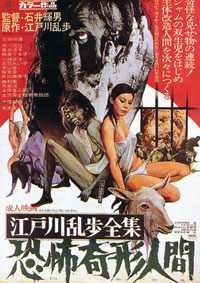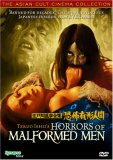| Reviews & Columns |
|
Reviews DVD TV on DVD Blu-ray 4K UHD International DVDs In Theaters Reviews by Studio Video Games Features Collector Series DVDs Easter Egg Database Interviews DVD Talk Radio Feature Articles Columns Anime Talk DVD Savant Horror DVDs The M.O.D. Squad Art House HD Talk Silent DVD
|
DVD Talk Forum |
|
|
| Resources |
|
DVD Price Search Customer Service #'s RCE Info Links |
|
Columns
|
|
|
Horrors of Malformed Men
Set in 1925, medical student Hirosuke Hitomi (Teruo Yoshida*) has been confined in an insane asylum. He doesn't quite remember how he got there or even who he is exactly, and in voice-over narration tries to piece together what has happened to him. He manages to escape, and just outside the hospital befriends Hatsuyo (Teruko Yumi), a beautiful circus performer who hums the same lullaby haunting Hirosuke's murky memories. After she's murdered and Hirosuke is wrongly accused of the deed, he flees to the seacoast hoping to unlock the secret of his past.
En route, he eyes an obituary for Genzaburo Komoda, the wealthy son of Jogoro, a mysterious eccentric landowner disfigured with webbed-fingers. Hirosuke is Genzaburo's spitting image, and after staking out the man's funeral decides to impersonate him, staging an elaborate "resurrection" from the dead. The first two-thirds of the film follow this very Edogawa-esque story, with Hirosuke's charade in constant danger of being discovered by Genzaburo's widow, Chiyoko [Chioko in the subtitles] (Michiko Obata), his mistress Shizuko (Yukie Kagawa), steward Hirukawa (Asao Koike), and former wet nurse Gindashi (Michi Tanaka).
The picture does a fine job telling its story from Hirosuke's isolated perspective. Is he insane? Amnesiac? After assuming Genzaburo's identity, there's a wonderfully realized sense of paranoia as he slips up here and there. (Looking at old photographs, he suddenly realizes that his double was left-handed, and later there's a tense scene where he's compelled to sign a document which surely will give him away.) The picture's opening act at the insane asylum is like a proto-pinku eiga ("pink film"): the hospital is populated mostly with young women, most of whom are topless for no particular reason other than sheer exploitation.
(Spoilers) The picture's reputation, however, rests on its bizarre last act, which finds Hirosuke/Genzaburo and several others traveling to Jogoro's remote island where the insane father (Tatsumi Hijikata) gleefully transforms normal human beings into "malformed" ones. Sort of a cross between The Island of Dr. Moreau and Freaks, Jogoro - who looks a lot like Christopher Lee's Rasputin - the Mad Monk (1966) - has twisted dreams of unleashing his creations upon the world.
Eschewing elaborate rubbery make-ups (as in the famous 1933 Moreau adaptation, Island of Lost Souls) or the use of people with real deformities (as in Tod Browning's Freaks), Ishii opted to avant-garde performance artists and dancers, most notably Hijikata, whose butoh performances of the late-1950s (dance based on the movements of the mentally ill and physically handicapped) were even more notorious than Ishii's film.
The results are decidedly mixed. On one hand, Hijikata's choreography, with his body contorting unnaturally among the cliff-sides, is genuinely disturbing but the deliberately artificial and theatrical make-ups, while visually interesting, more often than not are more surreal than frightening - and are crudely constructed. (When "Genzaburo" returns from the dead, he's discovered by two Buddhists priests, actors [possibly a manzai team considering the jarring shift into lowbrow comedy here] wearing the phoniest bald caps imaginable.) Jogoro's deformed hands, for instance, look like nothing more than normal hands dipped in pulpy wet plaster. In the end, Horrors of Malformed Men's climax is more an "absurdist pageant" (as colleague DVD Savant aptly puts it), an interesting but not-quite-successful effort along the lines of Fellini's superior "Toby Dammit" segment in Histoires extraordinaires (1968).
Cult filmmaker Teruo Ishii had a long and notably varied career, starting out at Shintoho studios where he made noirish thrillers and several of the Starman/Supergiants superhero fantasies starring Ken Utsui. Later he moved to Toei where he became friends with rising star Ken Takakura, and together made nearly a dozen "Abashiri Prison" movies, among Japan's most popular movies in all of the 1960s. No doubt his track record at Toei facilitated this much more personal project, which bears his stamp throughout. (At the same time, Rampo Edogawa's novels had become fashionable again; Kinji Fukasaku's wonderful Black Lizard (Kurotokage, 1968) was made at this time, as well as a concurrent TV series, Wanpaku tanteidan.)
Video & Audio
Snake Woman's Curse, in its original Toeiscope screen shape, looks splendid in a near-flawless 16:9 enhanced presentation both vivid and razor sharp. The opening titles are windowboxed, and the hues (originally Fujicolor) are accurately presented. The optional English subtitles are very good, though I wish either somewhere in the liner notes or on the film itself were complete credits. Overall a great transfer, however.
Extra Features
The many supplements include an audio commentary by Mark Schilling, who reviews contemporary films for The Japan Times and has written several excellent books on Japanese cinema. (He also does great play-by-play sumo commentary for NHK, but that's another story.) The commentary is excellent, informative, authoritarian and, best of all, quite personal, as Schilling relates many personal anecdotes about Ishii, whom he met several years before the director's death in 2005. My single complaint is the recording itself, whose audio is a little on the murky side.
Schilling and Ishii appear in a neat little featurette, Ishii in Italia, a cinema verite kind of piece that follows the two on a 2003 trip to the Far East Film Festival there. Malformed Memories is a 22-minute retrospective with directors Shinya Tsukamoto and Minoru Kawasaki talking warmly about Ishii's work; the effect is like sitting at a bar reminiscing nostalgically about movies seen as a child. Included is some behind-the-scenes footage of Ishii on the set of his last film, the shot-on-video Blind Beast vs. Dwarf (Moju tai Issunboshi, 2001), and clips from other Ishii films controlled by other boutique labels; it's heartening in this day and age to see these folks sharing material.
Also included is a fully translated 16:9 enhanced Japanese trailer, a great collection of poster images, and detailed biographies of Ishii and Rampo Edogawa, the former by writer Chris D.
Patrick Macias, Tomohiro Machiyama, and Jasper Sharp contribute useful and well-researched liner notes, touching upon other areas not in the commentary and featurettes.
As with Synapse's Snake Woman's Curse, the sleeve is reversible, so that customers can flip it over and choose the original Japanese poster art if they want - a nice little extra.
Parting Thoughts
Ishii's warped Magical Mystery Tour is like nothing you've ever seen. With its odd mix of absurdist theater, surreal images, taboo-breaking depravity, and commercially driven exploitation, it's all over the stylistic map and not for all tastes, but a fascinating film on many levels, Synapse and Panik House give it first class treatment. Highly Recommended.
* Yoshida also starred as the co-pilot in Goke, Bodysnatcher from Hell (Kyuketsuki Gokemidoro, 1968); he shares several early scenes with Hideo Ko at the insane asylum; Ko had played the vampire-like title character in that film.)
Film historian Stuart Galbraith IV's most recent essays appear in Criterion's three-disc Seven Samurai DVD and BCI Eclipse's The Quiet Duel. His audio commentary for Invasion of Astro Monster is now available.
|
| Popular Reviews |
| Sponsored Links |
|
|
| Sponsored Links |
|
|
| Release List | Reviews | Shop | Newsletter | Forum | DVD Giveaways | Blu-Ray | Advertise |
|
Copyright 2024 DVDTalk.com All Rights Reserved. Legal Info, Privacy Policy, Terms of Use,
Manage Preferences,
Your Privacy Choices | |||||||















